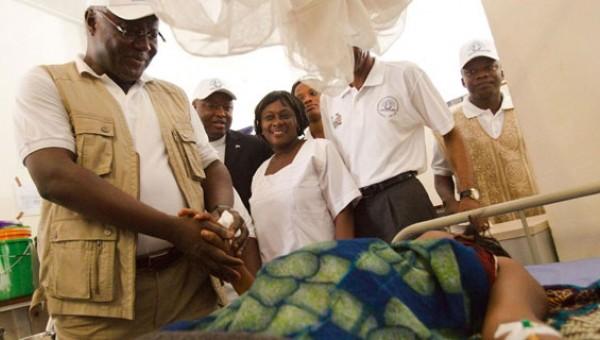
In November 2009, Sierra Leone President Dr. Ernest Bai Koroma launched a historic National Health Sector Strategic Plan (NHSSP), a five year plan to make health services readily available, accessible, and affordable. The “template that will accelerate progress within the health sector,” as described by the Vice-President Alhaji Samuel Sam-Sumana, underlined the need to move towards universal health coverage in the country and to reduce the spread of communicable diseases. The importance of the latter issue was brought to light during the 2012 cholera outbreak, which was the worst the country had experienced in 15 years and resulted in 400 deaths. Following the release of the NHSSP, the World Health Organization provided financial and technical support for its successful implementation and it has observed an overall positive trend towards access to care in the country.
Sierra Leone is a small West African country with a population just shy of 6 million. A decade-long civil war that claimed the lives of tens of thousands and destroyed the country’s infrastructure (as well as its water system, leading to a spur in waterborne diseases such as malaria) ended 12 years ago. Still, its infant mortality rate is among the highest globally at 89 per 1,000 births, and life expectancy is 47 years for males and 49 years for females.
WHO and the Sierra Leone Ministry of Health and Sanitation have worked hand in hand to identify key health needs and to target the most vulnerable populations. “The NHSSP is always the starting and end point for the health programs we support in Sierra Leone,” explains Dr. Denis Porignon, Health Policy Expert at WHO. “We’re not doing anything in parallel. Each development partner, be it UN agencies or the WHO, sees what needs to be done and determines from the plan what they can support.”
Dr. Teniin Gakuruh, the Health Systems Specialist of the WHO Country Office in Sierra Leone, explains that the organisation has been supporting six of the seven areas covered by the strategic plan: leadership and governance, service delivery, medicine and technology, human resource for health, health management information, and health care financing.
“In the last two years, we’ve been heavily involved in human resources profiling, followed by developing a human resources policy and strategic plan that was launched in 2013.” Why the emphasis on providing a clear picture of human resources in the health sector? When the Government of Sierra Leone introduced the Free Healthcare Initiative (FHCI) in 2010, the goal to provide free services to pregnant and lactating mothers as well as children under five was hindered by a inadequacy of skilled health workforce and demotivated staff.. Even though basic healthcare services were available to a vulnerable population due to abolition of user fees, there was an urgent need to determine and maintain records of genuine skilled staff, recruit additional health providers and adequately remunerate them.
The WHO subsequently developed a Human Resource Information System and separately Health Information System, allowing the Ministry of Health and Sanitation to keep track of local health actors and whether clinics have adequate infrastructure and oversight, not to mention water supply and power. The work on human resources provided by the WHO extends beyond monitoring HR Strategic Plan launched early last year into development of a training strategic plan that projects the number of skilled staff such as midwives needed over the next five to ten years.
Now less than a year away from the 2015 expiration date for the NHSSP, much work remains to be done. When asked about whether she is optimistic about the progress being accomplished in Sierra Leone, Dr. Gakuruh says: “The work that has been done post-conflict is very commendable, especially with the construction of new health facilities: the furthest a person can be from a clinic in the country is only eight kilometers (approximately five miles). The challenge now is not so much the availability of facilities, but according to our experience, it has to do with the lack of practitioners.”
